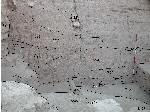| Description (summary) |
2009-09-13 |
lC |
Later escarpment dating, as the early escarpment, to the ED III. This second escarpment was built on top of the previous one replacing it, too damaged to continue to be used. The aim of this second escarpment was to protect the base of the revetment wall, most of all from the water that damaged the esc1. So, for this reason, it was built much higher than the previous one, covering about half of the height of the revetment wall. It is constructed of dumping material, most of all bricky material inside which many sealing impressions have been found. This material was brought from two directions: from south and from north, likely from the top of the revetment wall. This material filled the big cut f321 made in order to have a better construction of the second escarpment itself. [Input: T913LC.j] |
